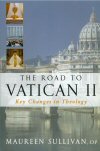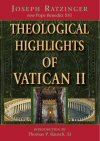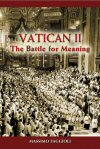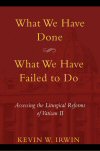Paulist Press Vatican II Collection (7 vols.)
Digital Verbum Edition
Overview
Study the significance and impact of the Second Vatican Council with the Paulist Press Vatican II Collection. Modern scholars and theologians, including Pope Benedict XVI and Maureen Sullivan, examine the contemporary Church in light of Vatican II. Trace the theological developments that led to that pivotal moment in Church history. Assess what work remains unfinished and how the modern Church can continue the liturgical reforms of the Council. Together these volumes provide insight into the Council’s influence on theology, spirituality, and Catholic social thought.
In the Verbum editions, these volumes are enhanced by amazing functionality. Important terms link to dictionaries, encyclopedias, and a wealth of other resources in your digital library. Perform powerful searches to find exactly what you’re looking for. Take the discussion with you using tablet and mobile apps. With Logos Bible Software, the most efficient and comprehensive research tools are in one place, so you get the most out of your study.
For more on the Second Vatican Council, as well as other important Catholic writings in the twentieth century, take a look at The John Paul II & John XXIII Canonization Bundle.
Key Features
- Covers the history, theology, and continuing interpretation of the Second Vatican Council
- Examines the impact of Vatican II on the Catholic Church today
- Includes theological highlights by Emeritus Pope Benedict XVI
Product Details
- Title: Paulist Press Vatican II Collection
- Publisher: Paulist Press
- Volumes: 7
- Pages: 1,441
- Christian Group: Catholic
- Resource Type: Topical
- Topic: Creeds, Councils, Confessions, and Catechisms
Individual Titles
- Living Vatican II by Gerald O’Collins
- The Road to Vatican II by Maureen Sullivan
- The Spirituality of the Second Vatican Council by Gerald O’Collins
- Still Interpreting Vatican II by Ormond Rush
- Theological Highlights of Vatican II by Joseph Ratzinger, Pope Benedict XVI
- Vatican II: The Battle for Meaning by Massimo Faggioli
- What We Have Done, What We Have Failed to Do: Assessing the Liturgical Reforms of Vatican II by Kevin W. Irwin

Vatican II was the first Council in the story of Catholic Christianity to deserve being labeled intercontinental and intercultural. What has been its impact? How should one describe and evaluate its reception by Catholics and its wider follow-up among others? How should this twenty-first Council be heard, received, and lived as we move further ahead into the twenty-first century? What perspectives does it offer for the future to those who seek to assimilate it creatively?
As a leading theologian, Gerald O’Collins uses a highly personal approach in answering these and many other questions, which makes for a compulsively readable book that illuminates the workings of the Church.
Living Vatican II explores the liturgical renewal after Vatican II, the reception of the Council’s moral teaching, the impact of Vatican II on theology, and the work of some key institutions in Rome and elsewhere toward implementing the teaching and decisions of this Council. Finally, the book offers insightful suggestions about the future of the Church.
Gerald O’Collins SJ, is a Jesuit priest and former dean of theology at Gregorian University in Rome. He is an honorary research fellow of MCD University of Divinity and an honorary adjunct professor at Australian Catholic University. He earned his BA and MA from the University of Melbourne, and was ordained a Jesuit priest in 1963. He earned his PhD from Cambridge University in 1968. He taught at the Pontifical Gregorian University in Rome from 1974 to 2006. He holds several honorary doctorates, and has earned many awards and honors. In 2006 he was made a Companion of the General Division of the Order of Australia for his contributions to theological scholarship and ecumenical initiatives. He is author or coauthor of 60 books, including A Concise Dictionary of Theology, 3rd ed., Jesus: A Portrait and The Legacy of John Paul II.

The Second Vatican Council produced a charter for the church of the twentieth century and beyond. Part of the Council’s fascination is that it involves many “stories.” The Road to Vatican II is an attempt to tell the story behind the stories of this landmark in church history.
Somehow, more than 2,500 bishops, who often disagreed on the most critical issues, managed to product 16 documents that touched the very essence of the Catholic faith. How is it possible that so much could have been accomplished in four brief Council sessions, from 1962 to 1965? How did the Church move from Pius IX at Vatican I (1869-1870) who espoused a rigid, hierarchical model of church to a John XXIII at Vatican II (1962-1965) a Council which ushered in a collegial, communio model of church?
In answering these questions, Maureen Sullivan highlights those theologians whose efforts over the years before the council were actually the seeds of what flourished at the Council. These theologians were indeed prophets among us, often suffering because of their convictions. Ultimately they were instruments of the Holy Spirit in our midst. They offered the Church a renewed vision of the faith and a methodology to facilitate theological endeavor. They also rediscovered in the New Testament a language of life that could speak to contemporary men and women.
This book presents the incredible theological changes that took place on the road to Vatican II; it examines the contributions of some of the key theologians on this road; and it finds evidence of their influence in key documents of the Second Vatican Council.
Maureen Sullivan earned her ThD from Fordham University and is assistant professor of theology at St. Anselm College, Manchester, New Hampshire. She is the author of 101 Questions and Answers on Vatican II in the 101 Questions and Answers Series.

This book presents the rich spirituality that Vatican II offers to all the faithful, a spirituality that has been widely neglected. Debates over the Council s theological and pastoral teaching continue to distract attention from the Council’s central message about the universal call to holiness. Such holiness attends to the manifold presence of the risen Christ, the life of the liturgy, the Scriptures that lead and feed us, the prophetic, priestly and pastoral mission of all believers, and the need to hear the cry of the poor.
Gerald O’Collins opens up some of the spiritual treasures to be found in the Vatican II documents, an area that has seldom come into view.
Gerald O’Collins SJ, is a Jesuit priest and former dean of theology at Gregorian University in Rome. He is an honorary research fellow of MCD University of Divinity and an honorary adjunct professor at Australian Catholic University. He earned his BA and MA from the University of Melbourne, and was ordained a Jesuit priest in 1963. He earned his PhD from Cambridge University in 1968. He taught at the Pontifical Gregorian University in Rome from 1974 to 2006. He holds several honorary doctorates, and has earned many awards and honors. In 2006 he was made a Companion of the General Division of the Order of Australia for his contributions to theological scholarship and ecumenical initiatives. He is author or coauthor of 60 books, including A Concise Dictionary of Theology, 3rd ed., Jesus: A Portrait and The Legacy of John Paul II.

Still Interpreting Vatican II proposes three phases of investigation. First, a hermeneutical inquiry must determine the meanings intended by the authors of Vatican II’s documents by reconstructing the “spirit” of the documents in the context of their conciliar debates and committee work. Second, a hermeneutic of the texts must look at issues of genre, structure, rhetoric, intratexuality, and intertextuality—all of which are significant in reconstructing the “letter” of the Council. Third, the effort to reconstruct both “spirit” and “letter” must be supplemented by attention to the post-conciliar reception of the Council and its texts.
Still Interpreting Vatican II concludes with a proposal that believers see the Holy Spirit at work not only in the Council’s letter and spirit, but in the continuing act and challenge of receiving the Council at the dawn of the third millennium. By pursuing these three hermeneutics and recognizing that the Spirit is still at work, the current impasse over interpreting Vatican II may yet be broken.
Ormond Rush, STD, is president of St. Paul’s Theological College in Banyo, Australia, where he lectures in foundational theology, theological hermeneutics, Christology, and the theology of creation.

Joseph Ratzinger, now Pope Benedict XVI, writes about the Council from the experience of one who was there—one who took part as an official peritus, or expert, in the work of Vatican II.
Regarded as one of the outstanding young theologians to emerge from the conciliar period, the author mirrors in his observations here his intimate familiarity with the theological issues discussed, the positions taken, and the battles fought. But he does not seek to record the “diplomatic factors, intramural power plays, and antagonism among groups.” His purpose is to “attempt to delineate the inner aspects, the spiritual profile of the Council.”
The book includes a special preface by the author setting forth the character of the observations as his “account of a personal journey through the landscape of each session, with an open view toward further developments.” There is also a new introduction written by Thomas Rausch, SJ, that provides a balanced and contemporary context for the book.
Joseph Ratzinger is one of the most revered Catholic prelates, scholars, theologians, teachers, and authors of our time. He has spoken on many crucial subjects, including sexual consumerism, roles of men and women today, marriage, the priesthood, and the future of the world. As a teenager, he initiated study of classical languages and entered the minor seminary in Traunstein in 1939. Though he was drafted into the German anti-aircraft corps in 1943, he re-entered the seminary in 1945, when World War II ended. On June 29, 1951, Joseph Ratzinger was ordained to the priesthood in the Cathedral of Freising on the Feast of Saints Peter and Paul. He also received his doctorate in theology in 1953 from the University of Munich. Starting in 1959, Ratzinger taught theology at the University of Bonn.
At age 35, Joseph Ratzinger was appointed chief theological advisor for the archbishop of Cologne, Cardinal Joseph Frings, and maintained that title for four years. After many years of teaching at several German universities, Ratzinger was appointed by Pope Paul VI as archbishop of Munich and Freising in March 1977, and was elevated to cardinal in June 1977. In November 1981, Ratzinger was summoned by Pope John Paul II to Rome, where he was named prefect of the Congregation for the Doctrine of the Faith, president of the Pontifical Biblical Commission, and president of the International Theological Commission.
On April 19, 2005, Joseph Ratzinger was elected to be the 265th pope. He took the name Benedict XVI, after St. Benedict of Nursia. Since that time, he has continued to receive worldwide respect and has been a spiritual influence to Christians and non-Christians alike.

For twenty-first-century Catholics and theologians interested in understanding contemporary Catholicism in light of Vatican II, Massimo Faggioli offers a balanced presentation of the Council’s key issues and their interpretation by major theologians and church historians at work in global Catholicism.
Massimo Faggioli is assistant professor of theology at the University of St Thomas in St. Paul, Minnesota. He earned his PhD in Turin, Italy, in 2002, and taught at the University of Bologna, the University of Bolzano, and the University of Modena-Reggio Emilia before moving to his current post. Among his many titles are: Sorting out Catholicism, True Reform, and Pope Francis: Tradition in Transition.

Kevin W. Irwin sheds light on the Catholic experience since theSecond Vatican Council. Focusing on implementing and praying the liturgy as reformed after the Council, this book invites discussion of how the Church can continue liturgical reform.
Kevin W. Irwin is professor of liturgical studies and sacramental theology at the Catholic University of America. He is the author of 101 Questions and Answers on the Mass in the 101 Questions and Answers Series.
For more on the Second Vatican Council, as well as other important Catholic writings in the twentieth century, take a look at The John Paul II & John XXIII Canonization Bundle.
Key Features
- Covers the history, theology, and continuing interpretation of the Second Vatican Council
- Examines the impact of Vatican II on the Catholic Church today
- Includes theological highlights by Emeritus Pope Benedict XVI
Product Details
- Title: Paulist Press Vatican II Collection
- Publisher: Paulist Press
- Volumes: 7
- Pages: 1,441
- Christian Group: Catholic
- Resource Type: Topical
- Topic: Creeds, Councils, Confessions, and Catechisms